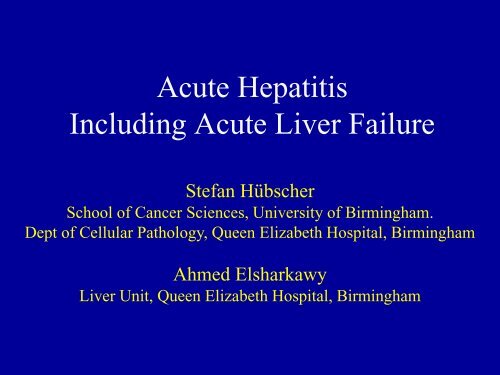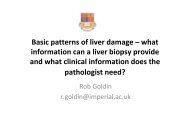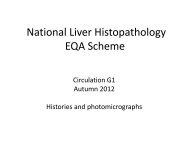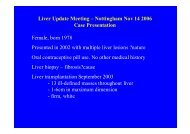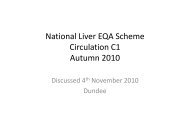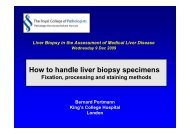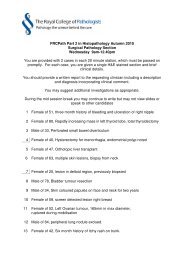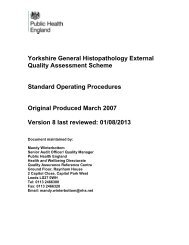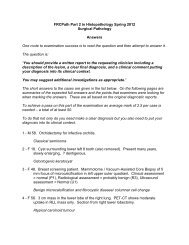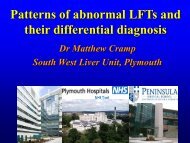Including Acute Liver Failure
Acute hepatitis, including acute liver failure – Professor Stefan ...
Acute hepatitis, including acute liver failure – Professor Stefan ...
You also want an ePaper? Increase the reach of your titles
YUMPU automatically turns print PDFs into web optimized ePapers that Google loves.
<strong>Acute</strong> Hepatitis<br />
<strong>Including</strong> <strong>Acute</strong> <strong>Liver</strong> <strong>Failure</strong><br />
Stefan Hübscher<br />
School of Cancer Sciences, University of Birmingham.<br />
Dept of Cellular Pathology, Queen Elizabeth Hospital, Birmingham<br />
Ahmed Elsharkawy<br />
<strong>Liver</strong> Unit, Queen Elizabeth Hospital, Birmingham
<strong>Acute</strong> liver failure<br />
<strong>Acute</strong> <strong>Liver</strong> Injury
<strong>Acute</strong> <strong>Liver</strong> <strong>Failure</strong> (ALF)<br />
FHF and LOHF<br />
• FHF : fulminant hepatic failure<br />
“The development of encephalopathy within 8<br />
weeks of the onset of symptoms, without<br />
previous liver disease.”<br />
• LOHF : late onset hepatic failure<br />
“Encephalopathy appears after 8 weeks, but<br />
within 6 months of symptom onset.”<br />
‣ subacute hepatic necrosis<br />
‣ subacute hepatic failure
<strong>Acute</strong> <strong>Liver</strong> <strong>Failure</strong> (ALF)<br />
FHF and LOHF<br />
• FHF<br />
‣ paracetamol poisoning<br />
‣ coagulopathy + +<br />
‣ cerebral oedema + +<br />
‣ hypoglycaemia<br />
‣ may present before jaundice<br />
‣ potential for recovery with conservative care<br />
• LOHF<br />
‣ seronegative hepatitis (non-A, non-B)<br />
‣ coagulopathy +<br />
‣ ascites +<br />
‣ jaundice ++<br />
‣ renal failure<br />
‣ conservative care fails, transplant indicated
<strong>Acute</strong> <strong>Liver</strong> <strong>Failure</strong> Admissions<br />
Birmingham <strong>Liver</strong> Unit 1987-2007<br />
1000<br />
800<br />
600<br />
400<br />
200<br />
0<br />
Seronegative<br />
AFLP/HELLP<br />
Other drug/toxin<br />
Miscellaneous<br />
POD<br />
Viral<br />
AVOD<br />
Wilsons<br />
Budd Chiari
<strong>Acute</strong> <strong>Liver</strong> Injury<br />
Establishing the Aetiology<br />
History<br />
• drug exposure<br />
‣ prescription<br />
‣ non-prescription<br />
‣ herbal<br />
• psychiatric and psychosocial issues<br />
• exposure to hepatitis viruses<br />
‣ travel (hepatitis A or E)<br />
‣ sex (hepatitis B)<br />
‣ blood exposure (hepatitis C or B)<br />
Examination<br />
• absence of signs of chronic liver disease<br />
• liver size
<strong>Acute</strong> <strong>Liver</strong> Injury<br />
Establishing the Aetiology<br />
Blood tests<br />
• routine biochemistry<br />
‣hyperacute (high transaminases, lower bilirubin)<br />
• paracetamol, ischaemia, hepatitis B<br />
‣subacute (lower transaminases, higher bilirubin)<br />
• seronegative hepatitis<br />
‣Wilson’s disease (low alkaline phosphatase)<br />
• paracetamol detection<br />
• viral serology<br />
‣IgM antibodies to HAV, HBV, HEV<br />
• liver immunology<br />
‣autoantibodies, immunoglobulins
<strong>Acute</strong> <strong>Liver</strong> Injury<br />
Establishing the Aetiology<br />
Imaging<br />
• ultrasound<br />
‣ liver size and texture<br />
‣ spleen size<br />
‣ ascites<br />
‣ oedematous gall bladder<br />
‣ infiltration<br />
• ? CT scan<br />
Biopsy<br />
• Some debate about usefulness<br />
• Can be important exclusion tool
<strong>Acute</strong> <strong>Liver</strong> Injury<br />
Establishing the Severity & Prognosis<br />
• Aetiology<br />
‣ paracetamol poisoning has unique prognostic criteria<br />
‣ seronegative hepatitis has poor prognosis<br />
• Duration of illness<br />
• Clinical features<br />
‣ shrinking liver<br />
‣ ascites<br />
• Biochemistry limited value<br />
• Coagulation important
Case 1
16 year old boy<br />
• Presented to local hospital June 2013<br />
• 2 week history of fatigue, anorexia, nausea and<br />
abdominal pain – off school<br />
• Increasing jaundice and pruritus<br />
• Weight loss over the same time period<br />
• No recent foreign travel<br />
• No tattoos, IVDU, paracetamol use, high risk<br />
sexual behaviour<br />
• No family history<br />
• PMH of asthma, allergic rhinitis and inguinal<br />
hernia repair
Admission Bloods and <strong>Liver</strong> Screen<br />
• Hb 15, WCC 7.7, Plt 287, MCV 67.8<br />
• Na 137, K 4.1, Ur 4.1, Creat 70<br />
• Bili 197, ALT 1965, ALP 273, Alb 36<br />
• PT 16.3 seconds<br />
• Paracetamol level 5<br />
• Ferritin 1850<br />
• Autoimmune screen negative, immunoglobulins<br />
normal, caeruloplasmin normal, Hep A, B C, E<br />
negative, CMV serology negative, EBV IgG<br />
positive but Monolatex test negative
USS at Local Hospital<br />
• The GB appears contracted<br />
• <strong>Liver</strong> and CBD are normal with no<br />
intrahepatic duct dilatation<br />
• The kidneys, spleen and pancreas are<br />
normal<br />
• Vasculature all patent<br />
• No ascites
Progress at Local Hospital<br />
500<br />
450<br />
400<br />
350<br />
300<br />
250<br />
200<br />
150<br />
100<br />
50<br />
4000<br />
3500<br />
3000<br />
2500<br />
2000<br />
1500<br />
1000<br />
500<br />
Bili<br />
ALT<br />
0<br />
Day 0 Day 2 Day 6 Day 8<br />
0
Day 9 + 10<br />
• Has transjugular liver biopsy performed<br />
• Transferred to QE in Birmingham with<br />
biopsy in formalin<br />
• Further history reveals no further<br />
aetiological clues<br />
• Patient clinically well but itch becoming<br />
increasingly troublesome
Why was the liver biopsy<br />
performed?<br />
• Evidence of on-going and worsening<br />
inflammatory activity?<br />
• Is this autoimmune hepatitis?<br />
• Is there anything histologically to predict a<br />
response to immunomodulatory therapy?
Case 1<br />
<strong>Liver</strong> Biopsy
<strong>Liver</strong> Biopsy in <strong>Acute</strong> Hepatitis<br />
Histological Approach<br />
1. Is this acute or chronic damage?<br />
2. How severe is the damage?<br />
3. What is the cause?
CK7
Ki 67
HVG
HVG
Case 1<br />
Diagnosis<br />
• <strong>Acute</strong> hepatitis<br />
• Moderately severe inflammatory activity, including<br />
foci of confluent/bridging necrosis<br />
• No strong aetiological pointers<br />
– Consider viral agents, drugs and autoimmune hepatitis in<br />
differential diagnosis
Days 11 - 16<br />
• Biopsy report received<br />
• Started on prednisolone 40 mg od on day 11<br />
• LFTs started to improve (see next slide)<br />
• Discharged with weekly outpatient follow up<br />
– no ascites at the time<br />
• Doing well on 20 mg of prednisolone at<br />
present<br />
• Only thing positive in repeat liver screen is a<br />
weakly positive ASMA
Prednisolone<br />
Started
Final Diagnosis<br />
Steroid Responsive Seronegative Hepatitis
Steroid Responsive SNH<br />
• Poorly understood entity<br />
• Rare<br />
• May represent ‘seronegative’ autoimmune<br />
hepatitis<br />
• Limited ability to predict response to steroids –<br />
presence of ascites may be important<br />
• No data on use of second line agents such as<br />
azathioprine<br />
• Limited data on relapse rates
Case 2
38 year old lady<br />
• Had been unwell with gastroenteritis 2 months<br />
prior to admission after holiday in Ireland<br />
• 1 month after that started on fluoxetine<br />
• 2 days later noticed that she was jaundiced<br />
• Was admitted at that stage and then discharged<br />
• Readmitted with worsening jaundice, peripheral<br />
oedema and ascites<br />
• PMH of asthma and fibroids<br />
• Alcohol – half a bottle of wine five days a week<br />
for last 2 years
Admission Bloods and <strong>Liver</strong> Screen<br />
• Hb 13.8, WCC 7.6, MCV 91.4, plts 195<br />
• INR 1.8<br />
• ALT 585, Bili 261, ALP 279, GGT 273, Alb 34,<br />
Na 135, K 4.1, Ur 2.7, Creat 56<br />
• Hepatitis A, B, C and E negative<br />
• Autoimmune profile and immunoglobulins<br />
negative<br />
• Other liver screen all negative<br />
• Leptospirosis negative
CT Performed at Day 1<br />
• Patchy enhancement in the liver but no<br />
focal lesions<br />
• Portal vein and hepatic vein patent<br />
• Normal CBD<br />
• Rest of organs normal<br />
• No ascites
Progress Days 1 - 8<br />
• Liaised daily with QE<br />
• Started on prednisolone on day 1<br />
• No significant change in LFTs<br />
• Prednisolone stopped day 8<br />
• Transferred to QE in view of on-going<br />
coagulopathy and jaundice<br />
• No suggestion of hepatic encephalopathy
Day 9 Admission to QE<br />
• Bilirubin 236<br />
• ALT 225<br />
• Albumin 25<br />
• INR 2.6<br />
• USS – fatty infiltration of the liver<br />
• Small amount of ascites seen<br />
• No liver flap
• In status quo<br />
Days 10 - 14<br />
• No sign of hepatic encephalopathy – number<br />
connection tests all less than 30 seconds<br />
• History reviewed fully on multi-consultant ward<br />
round<br />
• Some concerns about alcohol intake although<br />
no suggestion of dependency clinically<br />
• Also AST (250) higher than ALT (150 at this<br />
stage)<br />
• Caeruloplasmin low – ? Wilson’s<br />
• Transjugular liver biopsy arranged
Biopsy Planned<br />
• Questions –<br />
1. Is there evidence of acute alcoholic hepatitis<br />
2. Is there any suggestion of Wilson’s disease<br />
3. How severe is the amount of necrosis in the<br />
liver<br />
4. Is there any suggestion of spontaneous<br />
recovery
Case 2<br />
<strong>Liver</strong> Biopsy
HVG
PAS-D
<strong>Liver</strong> Biopsy – Case 2<br />
Histological Findings<br />
• Recent panacinar necrosis<br />
– Moderate inflammation (including ceroid laden macrophages ++)<br />
– Periportal ductular reaction<br />
– One small nodule surviving hepatocytes<br />
Comment<br />
• Likely to be a manifestation of severe acute hepatitis<br />
• No obvious aetiological pointers
Days 14 - 20<br />
• Stable<br />
• Biopsy suggests unlikely to recover<br />
• Transplant assessment tests performed<br />
• On day 18 develops liver flap in association with<br />
INR of 3.9<br />
• Sodium at the time 119<br />
• Transferred to ITU for CVVH<br />
• Listed for super-urgent liver transplant on day 19<br />
once sodium above 125<br />
• Transplant done on day 20
Transplant
Transplant
Case 2<br />
Hepatectomy Specimen
Case 2. Macroscopic Appearances<br />
Shrunken liver, weight 640 g. Wrinkled/knobbly capsular surface
Case 2 - Macroscopic Appearances
Case 2 - Macroscopic Appearances<br />
Right Lobe
Case 2 - Macroscopic Appearances<br />
Left lobe
HVG
Could this be cirrhotic?
Recent Post-Necrotic Collapse versus Longstanding Fibrosis<br />
Use Of Connective Tissue Stains<br />
Stain<br />
Material<br />
Demonstrated<br />
Distribution In<br />
Normal <strong>Liver</strong><br />
Changes In <strong>Liver</strong> Disease<br />
Reticulin<br />
Type III collagen<br />
fibres<br />
Portal tracts,<br />
hepatic sinusoids<br />
Collapse of reticulin<br />
framework in areas of<br />
recent liver cell necrosis.<br />
(few days)<br />
Haematoxylin<br />
Van Gieson<br />
Type I collagen fibres<br />
Portal tracts, walls<br />
of hepatic veins<br />
Increased in hepatic fibrosis<br />
(weeks/months)<br />
Orcein Elastic fibres Portal tracts,<br />
walls of hepatic<br />
veins<br />
Found in long-standing<br />
fibrosis/cirrhosis<br />
(months/years)
Retic
HVG
Orcein
Orcein
PAS-diastase<br />
CD 68<br />
Ceroid Pigment Laden Macrophages
Other Changes Seen in Areas of Parenchymal Necrosis<br />
Congestion<br />
May suggest a vascular problem – e.g. venous outflow obstruction
Hepatectomy Specimen – Case 2<br />
Histological Findings<br />
• Large areas of panacinar necrosis (multi-acinar necrosis)<br />
– Periportal ductular reaction<br />
– Inflammation of hepatic veins<br />
• Surviving areas of liver parenchyma<br />
– Nodular regeneration<br />
– Fatty change<br />
– Confluent /bridging necrosis<br />
– Little inflammation
Diagnosis<br />
Hepatectomy Specimen – Case 2<br />
• Severe acute hepatitis with multiacinar necrosis<br />
(submassive hepatic necrosis)<br />
• No strong aetiological pointers ( “seronegative<br />
hepatitis”)
Post Transplant Progress<br />
• Spent 3 days on intensive care<br />
• Spent another 5 days on the ward<br />
• On standard immunosuppresion<br />
• No episodes of rejection<br />
• Doing very well<br />
• LFTs all normal<br />
• Renal function normal
Final Diagnosis<br />
Seronegative hepatitis associated<br />
with fulminant liver failure<br />
requiring transplantation
Role of <strong>Liver</strong> Biopsy in <strong>Acute</strong> Hepatitis<br />
• Many of the classical morphological studies of acute hepatitis were carried<br />
out before the main causes had been discovered<br />
• Most cases of acute hepatitis now diagnosed on the basis of clinical,<br />
biochemical and serological findings and liver biopsy is rarely indicated<br />
• <strong>Liver</strong> biopsy may still be carried out in cases where the clinical presentation<br />
is atypical or the cause is uncertain<br />
– Confirm diagnosis of acute hepatitis<br />
– Determine disease severity<br />
– Identify possible aetiological factors (including cases of acute liver injury not<br />
related to hepatitis)
<strong>Liver</strong> Biopsy in <strong>Acute</strong> Hepatitis<br />
Histological Approach<br />
1. Is this acute or chronic damage?<br />
2. How severe is the damage?<br />
3. What is the cause?
Patterns of Inflammation in the <strong>Liver</strong><br />
• Portal Inflammation<br />
– Most chronic liver diseases (e.g. viral, autoimmune)<br />
– Also seen in acute hepatitis<br />
• Lobular Inflammation<br />
– Main pattern in acute hepatitis<br />
– Varying degrees of lobular inflammation also commonly present in<br />
chronic viral and autoimmune hepatitis<br />
• Mixed portal and lobular inflammation<br />
Pattern of inflammation alone cannot reliably distinguish chronic from acute hepatitis<br />
• Clinical context<br />
• Assessment of fibrosis (progressive fibrosis versus post-necrotic collapse)
Severe <strong>Acute</strong> Hepatitis (e.g. case 2)<br />
<strong>Acute</strong> versus Chronic Damage<br />
Clinical<br />
Severe acute hepatitis versus:<br />
• decompensated chronic liver disease (e.g. Wilson disease)<br />
• acute exacerbation of chronic liver disease (e.g. autoimmune hepatitis,<br />
hepatitis A/E superimposed on underlying cirrhosis)<br />
Histological<br />
• Areas of bridging necrosis & nodular regeneration can resemble<br />
changes occurring in cirrhosis<br />
• Areas of multiacinar necrosis can resemble inflamed fibrous septa in<br />
cirrhosis
Severe <strong>Acute</strong> Hepatitis (e.g. case 2)<br />
<strong>Acute</strong> versus Chronic Damage - Helpful pointers<br />
• Clinical context<br />
• Identification of normal vascular relationships<br />
• Use of connective tissue stains to determine age of lesions
<strong>Liver</strong> Biopsy in <strong>Acute</strong> Hepatitis<br />
Histological Approach<br />
1. Is this acute or chronic damage?<br />
2. How severe is the damage?<br />
3. What is the cause?
<strong>Liver</strong> Cell Death in <strong>Acute</strong> Hepatitis<br />
Pattern of Cell Death<br />
Histological Features<br />
Spotty necrosis<br />
Apoptosis of individual hepatocytes (acidophil bodies)<br />
Confluent necrosis<br />
(zone 3)<br />
Bridging necrosis<br />
Panacinar necrosis<br />
Loss of groups of adjacent liver cells<br />
Confluent necrosis linking vascular structures<br />
(central-central or central-portal bridging)<br />
Loss of hepatocytes in an entire acinus<br />
Multiacinar necrosis<br />
Panacinar necrosis involving several adjacent acini<br />
• Apoptosis > necrosis (in mild forms)<br />
• Severe necro-inflammatory lesions uneven in distribution<br />
‣ Sampling variability in liver biopsies<br />
‣ Extent of hepatocyte necrosis predictive of poor outcome in some studies (Katoonizadeh<br />
2006, Miraglia 2006, Rastogi 2011)
<strong>Liver</strong> Biopsy in <strong>Acute</strong> Hepatitis<br />
Histological Approach<br />
1. Is this acute or chronic damage?<br />
2. How severe is the damage?<br />
3. What is the cause?
<strong>Acute</strong> Hepatitis - Common Causes<br />
1. Viral<br />
• Hepatitis viruses – A,B,C,D, E<br />
• Other viruses – e.g. CMV, EBV<br />
2. Drugs<br />
3. Autoimmune<br />
4. Unknown<br />
• Seronegative hepatitis (“non-A, non-B, non-C hepatitis”)<br />
• Accounts for 40% of patients in the U.K presenting with<br />
severe acute hepatitis leading to acute liver failure (Ichai 2008,<br />
Bernal 2010)
<strong>Acute</strong> Hepatitis - Aetiological Considerations<br />
<strong>Liver</strong> biopsy rarely identifies a previously unsuspected aetiology<br />
• Biopsies mostly obtained from people in whom main recognised causes have been<br />
excluded (“seronegative hepatitis”)<br />
• Biopsy sometimes provides pointers to a previously unsuspected aetiology<br />
Aetiology<br />
Suggestive Histological features<br />
Drugs • Disproportionately severe / well-circumscribed necrosis<br />
(relatively little inflammation – lobular and/or portal)<br />
• Unusual patterns of necrosis - e.g periportal (zone 1) necrosis<br />
• Unusually prominent cholestasis<br />
• Eosinophils, granulomas<br />
Autoimmune<br />
hepatitis<br />
• Plasma cell rich infiltrate (also seen in hepatitis A)<br />
• Prominent periportal inflammation (interface hepatitis)<br />
• Prominent centrilobular inflammation (“central perivenulitis”)<br />
• Lymphoid aggregates
<strong>Acute</strong> Hepatitis - Aetiological Considerations<br />
<strong>Liver</strong> biopsy may identify a cause of acute liver injury not due to acute hepatitis<br />
• Decompensated chronic liver disease (e.g. Wilson’s disease)<br />
• Another cause of acute liver damage (e.g. ischaemic hepatitis, severe<br />
alcoholic hepatitis, paracetamol toxicity, herpes simplex hepatitis)<br />
• Hepatic infiltration (usually lymphoma, rarely carcinoma)<br />
– <strong>Liver</strong> usually enlarged


